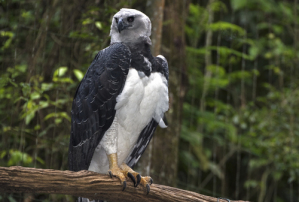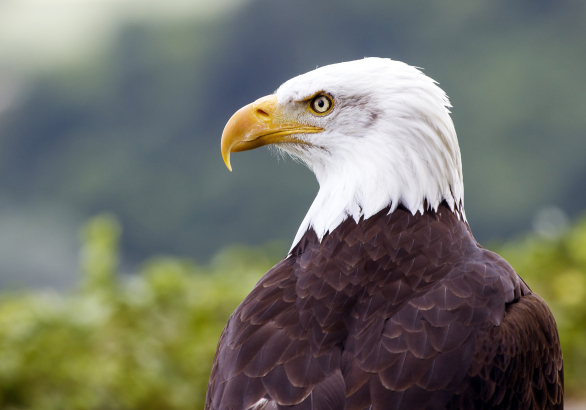Get to know more about these majestic species of bird with these interesting eagle facts.
Witten by: Niki Giovanis
What are Eagles?
For centuries eagles have traditionally been identified as symbols of heraldry and freedom. But what exactly distinguishes eagles from other types of birds, you may ask? The term eagle is used to classify large, strongly beaked, and big-footed birds of prey that belong to the Accipitridae family. For those of you who are unaware, birds of prey are the type of birds that hunt for other species of animals for food –seating them at the top of the food chain with other powerful Animalia kingdom members.

How Many Species of Eagles are There?
There are approximately 60 different species of eagles around the globe. While most eagle species inhabit Europe, Asia, and Africa, only 14 are found in other areas worldwide, including Australia, North, South, and Central America.
The eagle species have unofficially been divided into four groups. While generally, each group’s members are similar when it comes to their physical characteristics such as the shape of their bodies, their size, and diet, there is also a great deal of variety within each group.
Eagle Characteristics
Physical Appearance
Due to their extraordinary size, eagles are quite distinguishable amongst other species of birds. They have strong muscular legs, powerful talons, and large hooked beaks that enable them to hunt and eat their prey. An eagle’s size can vary in sizes as small as 17 to 22 inches(43.2 to 55.9 centimeters) in length to as large as 36 – 42 inches(91.4 to 106.7 centimeters) in length with a wingspan of over 79 inches(200.66 centimeters) wide!

Eyesight
Did you know that eagles can see four to five times farther than humans? This is mainly because an eagle’s retina contains more than a million light-detecting cells or cones per square millimeter, whereas humans only have around 200,000. Eagles also possess superior color visions as compared to humans. This allows them to differentiate between more shades, including ultraviolet light. In combination with each other, these eyesight characteristics are ultimately the reason why eagles possess such an extraordinary line of sight.
Interestingly enough, the size of an eagle’s eyeball can take up almost 50% of their head and can even weigh as much as the human eyeball and are angled 30 degrees away from the center of their face, giving them a greater field of vision and the ability to see up to three kilometers away.

Reproduction
Eagles are a monogamous species, meaning that they will only ever mate with one partner in their entire lifespan. Courtship occurs in the air with dramatic displays of behavior such as swooping and “fighting” to showcase their strength and agility, while the mating will occur on branches or in the nest. Depending on the geographic location, eagles will breed in different seasons. However, eagles will not mate until around the age of 4 or 5 years old.
Once mating is successful, a female will lay her eggs within 5 to 10 days with a clutch of 1 to 3 eggs. The incubation period can vary depending on the species of eagle. For example, while Golden Eagles incubate for 40 to 45 days, Bald Eagles only incubate for an average of 35 days. Both males and females share incubation responsibilities; however, the female will typically spend more time in the nest while the male leaves to hunt for food.
Further, depending on the species of eagle, fledging of the young birds will occur anywhere from 10 to 12 weeks, with full growth by 10 to 14 weeks.
Life Span
On average, eagles live to be around 20 to 30 years of age in the wild, which is considerably longer than other species of birds. When an eagle ages, its beak begins to warp and bend, causing great difficulty when feeding. This occurs because their beaks are made of keratin, as are our hair and nails. As the eagle ages, its body produces fewer amounts of the protein, which causes the weakness in their beaks. However, when an eagle is in captivity, they are known to live up to 70 years of age as they are cared for by the zookeepers who are able to assist them with feeding once they are too old to do so for themselves.
Diet
An eagle’s diet depends on which species it is and what food is available to it. However, all eagles can be classified as carnivorous animals, meaning they live on meat and fish diets primarily. When an eagle is hunting in a mountainous terrain, it will grab its prey by its talons and drop them from high heights to hinder them. Once the prey is dead, the eagle will feast on its meal.
The four groups of eagles
Now that we’ve learned a little bit about eagles as a whole let’s take a closer look at each group and learn what makes them distinguishable from each other.
Fish eagles
Fish eagles are also known as sea eagles or fishing eagles for their skillful fishing and feeding behaviors. This group is home to 11 different eagle species, including the famous Bald Eagle and the Stellar’s Sea Eagle, which is one of the largest birds on the planet, weighing from 10 to 20 pounds(4.5 to 9.1 kilograms)! Fish eagles live in the forested shores of lakes, rivers, and oceans. Their diet is heavily weighted in favor of fish, and they are not afraid to steal food from other birds. Fish eagle’s talons are coated in spicules, which help them hold onto fish and slippery prey.
Booted eagles
Booted eagles get their name from their feathered legs (boots) visible when they are perched. In comparison to other eagle species, they are medium-sized with long flight feathers and a square-shaped tail. Booted eagles are found in North Africa and all across Asia, living in wooded, hilly country sides. These eagles can be distinguished by their two-tone colorway: light grey with a darker head and flight feathers or a brownish dinge with dark grey flight feathers. Male eagles weigh about 1.5 pounds(680.4 grams), whereas females weigh about 2 pounds(907.2 grams) with wingspans of almost 4 feet wide(1.2 meters).
Snake eagles
Snake eagles are medium-sized birds that are mainly found in Africa; However, they have been spotted in the Mediterranean, the Middle East, and India. They live in open habitats with minimal trees. Snake eagles mainly prey on reptiles such as lizards and snakes; however, they occasionally hunt for small mammals.
Harpy eagles
Harpy Eagles are most distinguishable for their dark grey color and feathers that fan around their head’s tops into a crest. Harpy Eagles have thick talons that span up to 5 inches long. In this group of eagles, females are almost twice the size of males. Due to their large talons, they can prey on monkeys and sloths for dinner! You can find harpy eagles anywhere from Northern Argentina to Mexico in heavily forested areas.
More interesting Facts!
Before you go, here are some quick and extraordinary facts about these beautiful birds!
- Eagles are one of the fastest birds on the planet. They can fly to altitudes as high as 15,000 feet(4,572 meters) and fly up to 160 kilometers(99.42 miles per hour) per hour! That’s pretty impressive!
- On average, an eagle’s nest is 4 to 9 feet(1.2 to 2.7 meters) in diameter and 2 to 5 feet(60.9 centimeters to 1.5 meters) deep. An eagle’s nest can take anywhere from 1 to 3 months to build. However, eagles can sense urgency, so if their nest is damaged or destroyed, they will work-day and night to fix their homes.
- Just like humans, eagles are more active during the day, whereas at night, they rest.
- An eagle’s grasp can be up to 10 times stronger than humans.
- They are fierce hunters and overall intelligent creatures.
Niki Giovanis is a freelance writer who does not necessarily share the opinions expressed on BrantaMedia.com.
